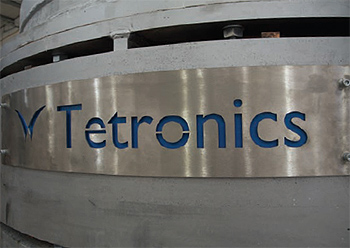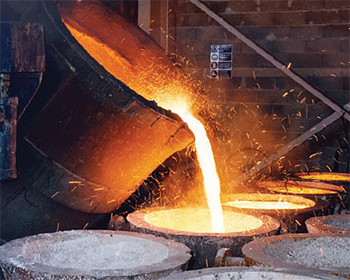Effective Waste Management and Resource Recovery by Tetronics
The fourth state
A leading environmental waste management company with over 50 years’ global experience, Tetronics delivers clean plasma technology for maximum resource recovery and the highest levels of hazardous material destruction
While societies discard items at a particular stage, that time isn’t always the end of the material’s life. Most have the potential to be reused, recovered or recycled in some form in order to generate further value, so allowing the resource to effectively become an ‘urban mine’. With waste being the only global resource not in decline, it makes sense that we change our behaviour  to extend the lifecycles of our resources and maximise their value – a more sustainable and future friendly approach.
to extend the lifecycles of our resources and maximise their value – a more sustainable and future friendly approach.
This is where Tetronics Plasma technology comes into its own – rather than disposing of materials that are considered ‘waste’, it is used to recover valuable materials where present and to transform the remainder into a safe inert product. Indeed, the company sees everything as having an opportunity for a closed-loop lifecycle.
However, to fully understand how Tetronics technology works, it is first necessary to examine what Plasma is. Plasma is simply an ionised or electrically charged gas, and is often described as the fourth state of matter, i.e. when energy is added to a solid (first state) it becomes a liquid (second state); with more added energy it becomes a gas (third state) and when further energy is added it eventually disassociates to become a plasma. Examples of plasma are lightning, sparks coming from static electricity, fluorescent lights, arc welding and the aurora borealis (northern and southern (polar) lights). Ninety-nine per cent of the Universe is made up of plasma.
Harnessing and enhancing the power of plasma, Tetronics’ process allows material feedstocks to be fed into a sealed furnace and heated in a controlled environment using a plasma arc created by either a single or multiple plasma electrodes/torches. The process chemistry is designed to preferentially separate and recover the valuable metals, minerals and other materials from the feedstock while destroying the hazardous elements, leaving behind a non-hazardous vitrified material. This vitrified material, called Plasmarok, can be employed as a building product for the construction industry.
The superb operating performance of plasma technology combined with its unmatched environmental compliance characteristics provides the secure business option for the treatment of and recovery from waste streams.
Furthermore, the intense temperature and ultra-violet light applied in the plasma treatment process results in an extremely high resource recovery rate and maximum Destruction and Removal Efficiency (DREs) of hazardous components for waste disposal and waste treatment.
In fact, plasma is one of the cleanest thermal processing technologies available, and this enables Tetronics’ systems to support an extensive range of applications, from recovery of precious metals and platinum group metals from spent catalysts, mining ores and electronics waste, to removing the toxicity of industrial materials such as asbestos and air pollution control residues. The company focuses its solutions in three key areas: resource recovery, hazardous material disposal and waste to energy.
Resource recovery
In this area Tetronics International is the global leader in the supply of clean plasma systems for a wide range of resource and precious metal recovery applications. Its solutions offer class leading recovery rates and are perfectly suited to treat a range of waste streams, including, but not limited to the following: Recovering precious metals from electronics; recovering platinum group metals from spent catalysts; recovery metals and minerals from ores/mining tailings; and recovering base metals from steel plant dusts.
Hazardous material disposal
Tetronics International is also the global leader in the supply of clean plasma systems for a wide range of hazardous and industrial waste treatment applications. Its systems are able to combat the asbestos hazard, where other technologies fail, as well as destroy chemical and biological warfare agents and their precursors, not only because of its tolerance to different waste material types but also crucially because of its ability to destroy the hazards these incredibly harmful wastes and to and transform any residues into a stable vitrified material.
The organisation can also deal with nuclear waste and in this area, Tetronics has a strong track record of working within the nuclear industry on a range of demonstration and R&D activities, and especially in the area of intermediate level waste.
Tetronics’ plasma technology is also capable of treating organic wastes including Polychlorinated Biphenyls (PCBs) and other types of Persistent, Bio-accumulative, and Toxic (PBT) pollutants at very high efficiencies across a wide range of concentrations.
The other areas that can benefit from plasma technology are petrochemical wastes, which offers commercial advantages over existing waste management options: residue wastes, where Tetronics has been providing clean plasma technology to its customers for over 20 years, particularly for the management of fly ash and Air Pollution Control residues (APCr) generated from incinerators and other Waste to Energy (WtE) processes.
Finally Tetronics offers a safe and permanent treatment solution for Spent Potliner (SPL), thereby overcoming one of the biggest challenges faced by the global primary aluminium production sector. Tetronics’ robust solution delivers leading environmental credentials for the management of this highly problematic waste stream.
Waste to energy and fuels
The Tetronics solution that produces energy from waste is supplied via its partner, Advanced Plasma Power (APP). Working with Tetronics, APP has developed the Gasplasma process, a clean, modular and scalable advanced waste to energy and fuels technology, which delivers high efficiencies, whilst minimising visual and environmental impact during waste recycling.
The Gasplasma technology is a two-stage advanced conversion process. It combines two long-standing and well-proven technologies (gasification and plasma conversion) in a unique configuration. After the removal of valuable recyclates, the Gasplasma process treats a wide range of non-recyclable feedstocks produced from residual municipal solid waste and commercial/industrial waste converting them all into two high value outputs: a clean, high quality, energy-rich synthesis gas (syngas) and a solid, vitrified product (Plasmarok) – each with multiple applications.
Summary
It is clear that Tetronics’ success is based around its expertise in technology, and this level of technological innovation can only be maintained by a constant dedication to investment – the company currently has 109 patents either granted or pending across 12 families. It also has a long list of successful projects that it can draw experience from, including a UK pilot project converting household waste to methane, a metal recovery plant in Russia and a recycling plant in Germany. This means that to date, it has used its plasma technology to process a huge range of materials; therefore, it is highly likely the company can assist almost any customer with their hazardous waste disposal questions.
As the company states on its website, it is continually listening, learning, responding and adapting its solutions to customer needs, and constantly stretching itself to remain at the forefront of technological advancements for delivering effective resource recovery, hazardous waste disposal and plasma waste management services.
‘At Tetronics, we have been innovators since our inception, pushing back the boundaries of the possible for 50 years, sharing our expertise to solve real-world problems across diverse sectors, geographies and technology environments,’ the company states. With this know-how, Tetronics’ customers can rest assured that they will be completely supported in dealing with their material challenges in the most stable and cost effective way.
Tetronics International
Services: Clean plasma technology
